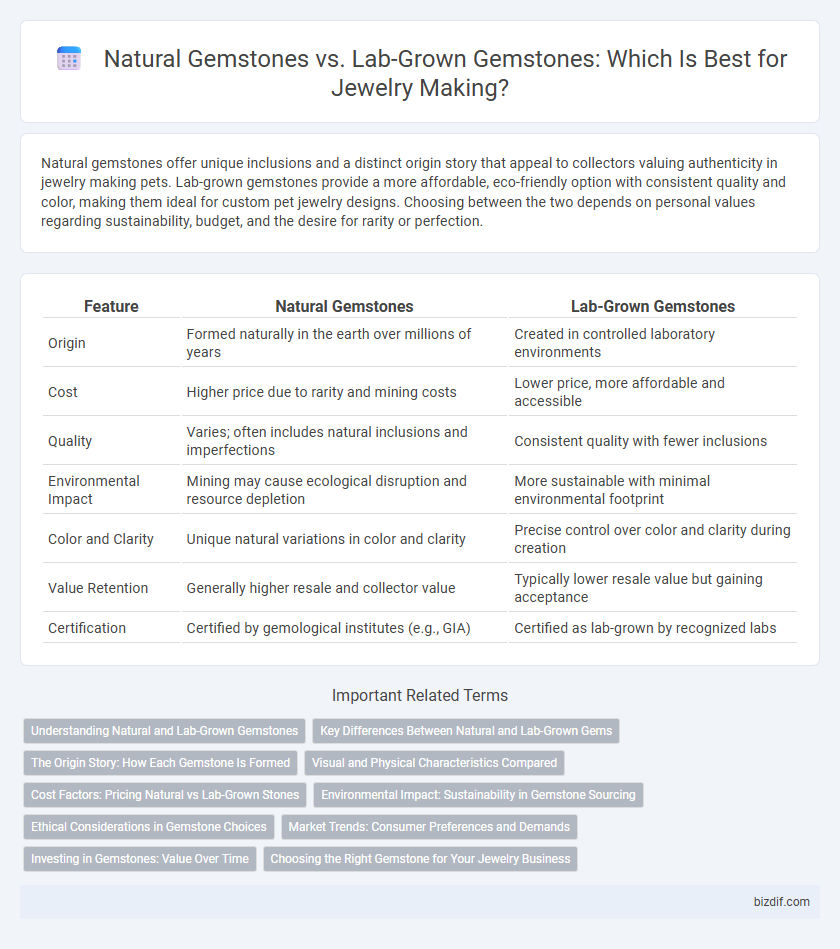Natural gemstones offer unique inclusions and a distinct origin story that appeal to collectors valuing authenticity in jewelry making pets. Lab-grown gemstones provide a more affordable, eco-friendly option with consistent quality and color, making them ideal for custom pet jewelry designs. Choosing between the two depends on personal values regarding sustainability, budget, and the desire for rarity or perfection.
Table of Comparison
| Feature | Natural Gemstones | Lab-Grown Gemstones |
|---|---|---|
| Origin | Formed naturally in the earth over millions of years | Created in controlled laboratory environments |
| Cost | Higher price due to rarity and mining costs | Lower price, more affordable and accessible |
| Quality | Varies; often includes natural inclusions and imperfections | Consistent quality with fewer inclusions |
| Environmental Impact | Mining may cause ecological disruption and resource depletion | More sustainable with minimal environmental footprint |
| Color and Clarity | Unique natural variations in color and clarity | Precise control over color and clarity during creation |
| Value Retention | Generally higher resale and collector value | Typically lower resale value but gaining acceptance |
| Certification | Certified by gemological institutes (e.g., GIA) | Certified as lab-grown by recognized labs |
Understanding Natural and Lab-Grown Gemstones
Natural gemstones form over millions of years through geological processes, resulting in unique inclusions and variations that make each stone distinct. Lab-grown gemstones are created in controlled environments using advanced technology, producing stones with the same chemical, physical, and optical properties as natural ones but often at a lower cost and with fewer impurities. Understanding these differences helps jewelry makers choose the ideal material for durability, aesthetic appeal, and ethical considerations.
Key Differences Between Natural and Lab-Grown Gems
Natural gemstones form over millions of years through geological processes, resulting in unique inclusions and variations that authenticate their origin and rarity. Lab-grown gemstones are created in controlled environments using advanced technology, producing gems with consistent clarity and color, often at a lower cost. Key differences include natural gems' rarity and higher market value, while lab-grown gems offer ethical sourcing, eco-friendliness, and enhanced physical properties.
The Origin Story: How Each Gemstone Is Formed
Natural gemstones form over millions of years through geological processes involving heat, pressure, and mineral crystallization deep within the Earth's crust. Lab-grown gemstones, created in controlled environments, replicate these natural conditions using advanced technologies like hydrothermal synthesis or chemical vapor deposition to produce gems with identical physical and chemical properties. Understanding the origin story of each gemstone enhances appreciation for their uniqueness, with natural gems reflecting Earth's ancient history and lab-grown gems embodying modern scientific innovation.
Visual and Physical Characteristics Compared
Natural gemstones display unique inclusions and color variations formed by geological processes, giving each stone distinct visual patterns and slight imperfections. Lab-grown gemstones offer consistent clarity, color, and fewer inclusions due to controlled manufacturing, resulting in near-flawless physical attributes. Both types share similar hardness and refractive indices, but natural stones possess subtle variances that collectors and jewelers often value for authenticity.
Cost Factors: Pricing Natural vs Lab-Grown Stones
Natural gemstones typically command higher prices due to their rarity, unique inclusions, and the extensive mining processes involved, which significantly increase costs. Lab-grown gemstones offer a more affordable alternative by replicating the physical and chemical properties of natural stones in controlled environments, reducing production expenses. Pricing differences are also influenced by consumer perception, with natural stones often valued for their authenticity and heritage, while lab-grown stones present budget-friendly options with comparable quality.
Environmental Impact: Sustainability in Gemstone Sourcing
Natural gemstones often require extensive mining processes that can lead to habitat destruction, soil erosion, and water pollution, posing significant environmental challenges. Lab-grown gemstones offer a sustainable alternative by utilizing controlled technology to produce high-quality gems with a minimal ecological footprint and reduced energy consumption. Choosing lab-grown stones supports ethical sourcing practices while preserving natural ecosystems and reducing carbon emissions associated with traditional mining.
Ethical Considerations in Gemstone Choices
Natural gemstones often raise ethical concerns due to mining practices linked to environmental damage and labor exploitation, prompting consumers to seek alternatives. Lab-grown gemstones provide a sustainable and conflict-free option, created without harming ecosystems or involving unethical labor. Choosing lab-grown stones supports ethical sourcing and reduces the jewelry industry's ecological footprint while maintaining the beauty and durability valued by artisans and customers.
Market Trends: Consumer Preferences and Demands
Natural gemstones maintain a strong appeal due to their rarity, unique inclusions, and traditional value, driving demand among collectors and luxury buyers. Lab-grown gemstones gain significant market traction by offering affordable, ethically sourced, and environmentally sustainable alternatives, attracting millennials and eco-conscious consumers. Current market trends highlight a growing shift towards lab-grown stones in fast fashion and everyday jewelry sectors, while natural gemstones continue to dominate high-end and investment-grade jewelry markets.
Investing in Gemstones: Value Over Time
Natural gemstones often retain higher long-term value due to their rarity and unique geological origin, making them preferred investments for collectors and investors. Lab-grown gemstones, while visually identical and more affordable, generally depreciate faster because they are mass-produced and lack the scarcity factor. Investing in natural gemstones requires careful evaluation of factors like provenance, clarity, and carat weight to maximize value appreciation over time.
Choosing the Right Gemstone for Your Jewelry Business
Natural gemstones offer unique inclusions and variations that appeal to clients seeking authenticity and rarity, while lab-grown gemstones provide consistent quality and ethical sourcing valuable for sustainable business practices. Understanding customer preferences and market demand is crucial when deciding between natural and lab-grown options for inventory diversification. Prioritizing high-quality certification and traceability enhances trust and adds value to your jewelry offerings.
Natural gemstones vs Lab-grown gemstones Infographic

 bizdif.com
bizdif.com